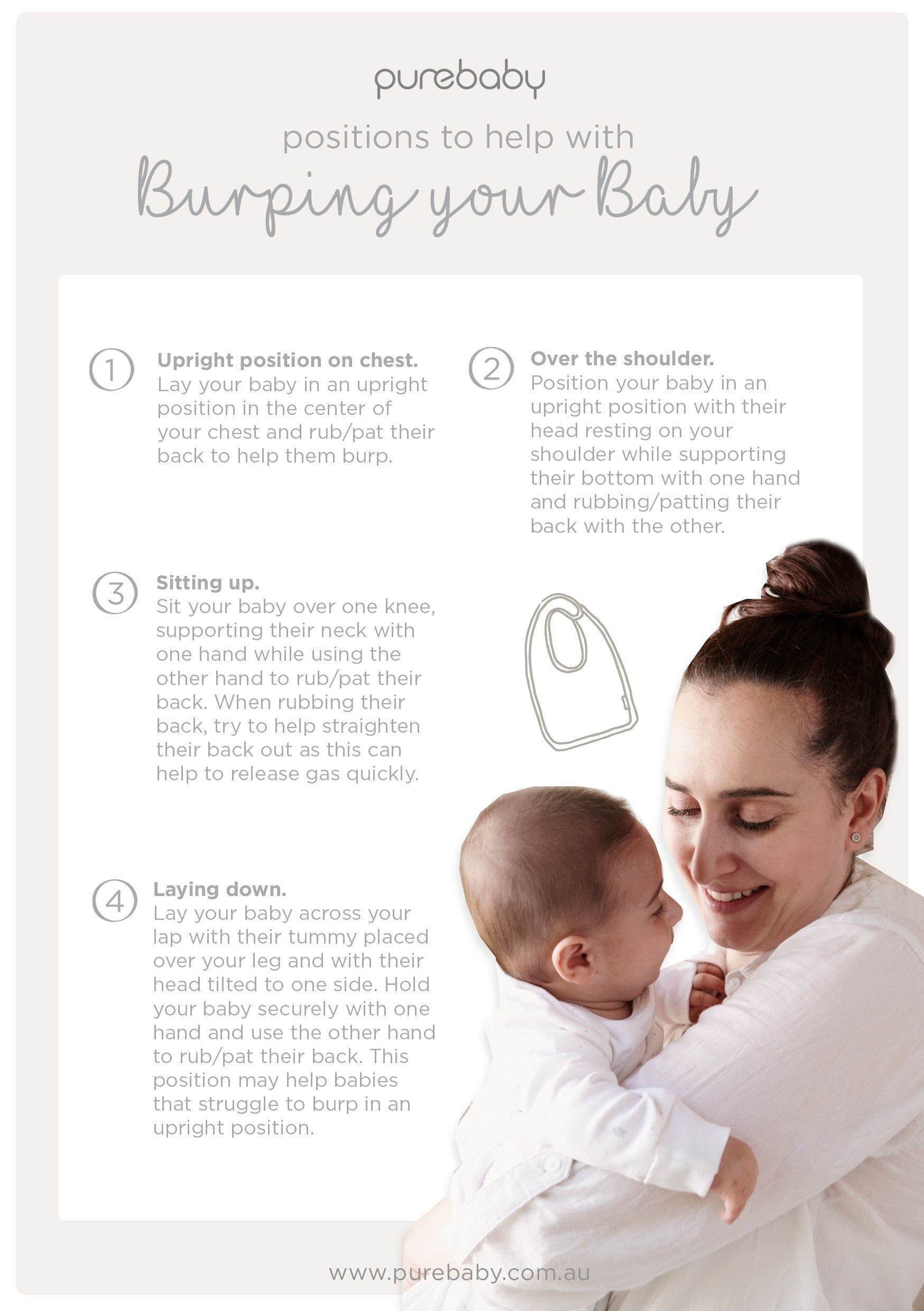
Pure Nutrition: Introducing Baby to Solid Foods
14 min read | 4 October 2020
8 min read | 14 February 2021

Burping your baby during and after a feed can help to keep them settled and lead to more effective feeding. Babies, just like us, swallow air as they feed. If they are unable to release that air it can cause them to feel full too fast, spit up or become fussy and unsettled due to the discomfort in their tummies, which can all lead to poor feeding.
Babies who are breastfed, generally swallow less air and should be burped when changing breasts and at the end of each feed. It’s important to note that if you have an oversupply or fast let-down, this can affect how much air your baby is swallowing during a feed.
Babies that are bottle-fed should be burped halfway through a feed and at the end of a feed, or if they are showing signs of being full sooner than expected. Most babies will not need assistance with burping once they reach 4-6 months of age, as they become more mobile and active. Monitoring your baby’s progress as they grow will help you to assess when they will no longer require burping, as each baby is different and will progress at a different rate.
Your baby may spit up while burping them, this is
normal.
Always keep a burp cloth or
muslin wrapon you while you feed, to protect yourself and your clothing from spit-up.
Most babies only require a gentle circular rub or pat on their back to bring up their gas, but some may require a firmer pat to bring up those tricky burps.
If your baby becomes fussy during a feed, this may be a sign that they have swallowed too much air. In this case, burp your baby in the middle of a feed to help release the gas and ease the discomfort they may be feeling.
When burping your baby, aim to pat the left side of their back as this is where their stomach is and it will help them to release gas quicker.
Upright position on chest
– babies that are breastfed often swallow less air when feeding and may only require minimal burping. Lay your baby in an upright position in the center of your chest and rub/pat their back to help them burp.
Over the shoulder
– position your baby in an upright position with their head resting on your shoulder while supporting their bottom with one hand and rubbing/patting their back with the other.
Sitting up
– sit your baby over one knee, supporting their neck with one hand while using the other hand to rub/pat their back. When rubbing their back, try to help straighten their back out as this can help to release gas quickly.
Laying down
– lay your baby across your lap with their tummy placed over your leg and with their head tilted to one side. Hold your baby securely with one hand and use the other hand to rub/pat their back. This position may help babies that struggle to burp in an upright position.

Babies digestive tracts are still developing and learning what to do in the first few months of life. This includes learning how to create and process gas. It’s normal for babies to have wind as a part of a healthy digestive system, but being able to help them pass gas when they are in pain can make a big difference.
Some suggestions to help with relieving wind:
Tummy massage
– rubbing in a rhythmical circular motion on their lower belly
Cycle legs
– moving their legs in a rhythmical circular motion like riding a bike
Warm baths
– to help relax them
Upright position
– keep baby in an upright position after feeding
Walking/bouncing
– walking around and with a gentle bounce
Cradle over arm
– cradling baby face down over your arm to help apply pressure to the tummy and bowels.
If you find that your baby is suffering from excessive wind, which is causing them to become distressed regularly, it may be due to them swallowing too much air when feeding. A poor latch when breastfeeding can cause babies to swallow too much air. You may wish to consider getting in touch with a medical professional or lactation consultant to help you achieve a better latch. If your baby is bottle-fed you may need to consider getting a slower-paced teat and burping your baby more regularly throughout each feed.
Excessive crying or fussiness for regular and prolonged periods of time may be a sign that your baby is suffering from colic. Colic can be distressing for both baby and parents, and it’s important to seek help from a medical professional if you are concerned that your baby may be suffering from colic.
Before you know it, burping your baby will become a second nature and during those hazy night feeds you won’t even realise you’re doing it. Remember, if you have any concern about your baby’s feeding, burping or wind pain, seek medical advice from a professional to help ease your worries.
Learn more about baby’s next feeding milestone and how to introduce solid foods with Pure Parenthood, our expert-led parenting podcast.
Sign up to Pure Love Rewards and get $10 off your first online order, earn points every time you shop and more!